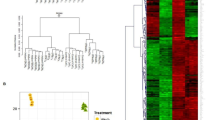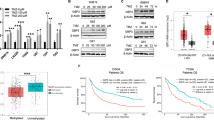Abstract
Temozolomide (TMZ) is a chemotherapeutic used for the treatment of glioblastoma. The MGMT repair enzyme (O′-(6)-methyl guanine-DNA-methyltransferase) promoter methylation is a predictive biomarker to TMZ response; interferons (IFNs) type I can downregulate MGMT expression improving survival in patients with unmethylated MGMT promoter. HeberFERON is a co-formulation of IFNs type I and II with higher antiproliferative effect over glioblastoma cell lines than individual IFNs. We investigated the proliferative response of patient-derived glioblastoma cultures to HeberFERON and its combination with TMZ in relation to MGMT promoter methylation and the regulation of MGMT transcript after HeberFERON treatment. Eleven glioblastoma-derived cultures, molecularly classified according to TCGA and MGMT promoter methylation, were assayed for proliferation inhibition with HeberFERON at low doses (1–25 IU/mL) [alone or combined with TMZ] or at higher doses (50–200 IU/mL) using CellTiter-Glo Luminescent Cell Viability Assay (Promega). Eight cultures were further treated with 100 IU/mL of HeberFERON for 72 h, total RNA purified (Qiagen) and converted to cDNA (Superscript III kit, Invitrogen) as quantitative PCR templates. Changes of MGMT&P53 transcripts level were monitored. Response of cultures to HeberFERON is variable, dose-dependent and apparently independent from TCGA classification and MGMT methylation status, based on the eight Classical cultures data. When combining HeberFERON with TMZ there was an increase in cell death for cultures, 2/4 with methylated and 5/5 with unmethylated MGMT promoter. In two out five cultures with unmethylated MGMT status, we observed a decrease of MGMT gene levels and an increase in P53 encoding gene levels. HeberFERON and TMZ combination should be further assayed in glioblastoma, mainly for those with unmethylated MGMT promoter.


Similar content being viewed by others
Data availability
Available antiproliferative and gene expression analysis data will be available through the corresponding author.
References
Rybalkinaa E, Pavlovab G, Stavrovskayaa A (2015) Recent news in the glioblastoma research. Biochem (Mosc) Suppl Ser Membr Cell Biol 9:1–12
Khosla D (2016) Concurrent therapy to enhance radiotherapeutic outcomes in glioblastoma. Ann Transl Med 4:54
Hegi ME, Diserens AC, Gorlia T et al (2005) MGMT gene silencing and benefit from temozolomide in glioblastoma. N Engl J Med 352:997–1003
Szopa W, Burley TA, Kramer-Marek G, Kaspera W (2017) Diagnostic and therapeutic biomarkers in glioblastoma: current status and future perspectives. BioMed Res Int. https://doi.org/10.1155/2017/8013575
Natsume A, Ishii D, Wakabayashi T, Tsuno T, Hatano H, Mizuno M, Yoshida J (2005) IFN-B down-regulates the expression of DNA repair gene MGMT and sensitizes resistant glioma cells to temozolomide. Cancer Res 65:7573–7579
Shen D, Guo CC, Wang J et al (2015) Interferon-α/β enhances temozolomide activity against MGMT-positive glioma stem-like cells. Oncol Rep 34:2715–2721
Motomura K, Natsume A, Kishida Y et al (2011) Benefits of interferon-β and temozolomide combination therapy for newly diagnosed primary glioblastoma with the unmethylated MGMT promoter: a multicenter study. Cancer 117:1721–1730
Yung WK, Prados M, Levin VA, Fetell MR, Bennett J, Mahaley MS, Salcman M, Etcubanas E (1991) Intravenous recombinant interferon beta in patients with recurrent malignant gliomas: a phase I/II study. J Clin Oncol 9:1945
Fine HA, Wen PY, Robertson M, O’Neill A, Kowal J, Loeffler JS, Black PM (1997) A phase I trial of a new recombinant human beta-interferon (BG9015) for the treatment of patients with recurrent gliomas. Clin Cancer Res 3:381–387
Colman H, Berkey BA, Maor MH, Groves MD, Schultz CJ, Vermeulen S, Nelson DF, Mehta MP, Yung WK (2006) Radiation Therapy Oncology Group Phase II Radiation Therapy Oncology Group trial of conventional radiation therapy followed by treatment with recombinant interferon-beta for supratentorial glioblastoma: results of RTOG 9710. Int J Radiat Oncol Biol Phys 66:818–824
Bello-Rivero I, Garcia-Vega Y, Duncan-Roberts Y, Vazquez-Blomquistc D, Santana-Milian H, Besada-Perez V, Rios-Cabrera M (2018) HeberFERON, a new formulation of IFNs with improved pharmacodynamics: perspective for cancer treatment. Semin Oncol 45:27–33
Balvers RK, Kleijn A, Kloezeman JJ, French PJ, Kremer A, van den Bent MJ, Dirven CMF, Leenstra S, Lamfers MLM (2013) Serum-free culture success of glial tumors is related to specific molecular profiles and expression of extracellular matrix-associated gene modules. Neuro-Oncology 15:1684–1695
Verhaak R, Hoadley K, Purdom E et al (2010) An integrated genomic analysis identifies clinically relevant subtypes of glioblastoma characterized by abnormalities in PDGFRA, IDH1, EGFR and NF1. Cancer Cell 17:1–25
Vázquez-Blomquist D, Fernández J, Miranda J, Bello C, Silva J, Estrada R, Novoa L (2012) Selection of reference genes for use in quantitative reverse transcription PCR assays when using interferons in U87MG. Mol Biol Rep 39:11167–11175
Pfaffl M, Horgan G, Dempfle L (2002) Relative expression software tool (REST©) for group-wise comparison and statistical analysis of relative expression results in real-time PCR. Nucleic Acids Res 30:1–10
Tabatabai G, Stupp R, van den Bent MJ, Hegi ME, Tonn JC, Wick W, Weller M (2010) Molecular diagnostics of gliomas: the clinical perspective. Acta Neuropathol 120:585–592
Wakabayashi T, Kayama T, Nishikawa R et al (2011) A multicenter phase I trial of combination therapy with interferon-β and temozolomide for high-grade gliomas (INTEGRA study): the final report. J Neurooncol 104:573–577
Wakabayashi T, Natsume A, Mizusawa J et al (2018) JCOG0911 INTEGRA study: a randomized screening phase II trial of interferonβ plus temozolomide in comparison with temozolomide alone for newly diagnosed glioblastoma. J Neurooncol 138:627–636
Groves MD, Puduvalli VK, Gilbert MR et al (2009) Two phase II trials of temozolomide with interferon-alpha2b (pegylated and non-pegylated) in patients with recurrent glioblastoma multiforme. Br J Cancer 101:615–620
Garcia-Vega Y, Salva-Camaño S, García-Iglesias E, Cubero-Rego D, González-Gonzalez J, Bello-Rivero I (2015) CIGB-128, as compassionate intracranial treatment in patients with non-operable or progressive high grade gliomas. J Cancer Res Ther 3:136–143
Kleijn A, Kloezeman JJ, Balvers RK, van der Kaaij M, Dirven CMF, Leenstra S, Lamfers MLM (2016) A systematic comparison identifies an ATP-based viability assay as most suitable read-out for drug screening in glioma stem-like cells. Stem Cells Int. https://doi.org/10.1155/2016/5623235
Yang JL, Qu XJ, Russell PJ, Goldstein D (2005) Interferon-alpha promotes the anti-proliferative effect of gefitinib (ZD 1839) on human colon cancer cell lines. Oncology 69:224–238
Yang JL, Qu XJ, Russell PJ, Goldstein D (2005) Interferon-alpha promotes the anti-proliferative effect of Erlotinib (OSI-774) on human colon cancer cell lines. Cancer Lett 225:61–74
Bruzzese F, Di Gennaro E, Avallone A, Pepe S, Arra C, Caraglia M, Tagliaferri P, Budillon A (2006) Synergistic antitumor activity of epidermal growth factor receptor tyrosine kinase inhibitor gefitinib and IFN-alpha in head and neck cancer cells in vitro and in vivo. Clin Cancer Res 12:617–625
Díaz A, Batista AE, Montero E (2009) Interferon-alpha conditioned sensitivity to an anti-epidermal growth factor receptor monoclonal antibody in a human lung cancer cell line with intermediate expression of the receptor. J Interferon Cytokine Res 29:433–440
Venkatesan S, Lamfers MLM, Dirven CMF, Leenstra S (2016) Genetic biomarkers of drug response for small-molecule therapeutics targeting the RTK/Ras/PI3K, p53 or Rb pathway in glioblastoma. CNS Oncol 5:77–90
Swiatek-Machado K, Kaminska B (2013) STAT signaling in glioma cells. In: Barańska J (ed) Glioma signaling, advances in experimental medicine and biology. Springer, Dordrecht, pp 189–208
Rahaman SO, Harbor PC, Chernova O, Barnett GH, Vogelbaum MA, Haque SJ (2002) Inhibition of constitutively active Stat3 suppresses proliferation and induces apoptosis in glioblastoma multiforme cells. Oncogene 21:8404–8413
Lo HW, Cao X, Zhu H, Ali-Osman F (2008) Constitutively activated STAT3 frequently coexpresses with epidermal growth factor receptor in high-grade gliomas and targeting STAT3 sensitizes them to Iressa and alkylators. Clin Cancer Res 14:6042–6054
Su Y, Li G, Zhang X, Gu J, Zhang C, Tian Z, Zhang J (2008) JSI-124 inhibits glioblastoma multiforme cell proliferation through G(2)/M cell cycle arrest and apoptosis augment. Cancer Biol Ther 7:1243–1249
Premkumar DR, Jane EP, Agostino NR, Scialabba JL, Pollack IF (2010) Dasatinib synergizes with JSI-124 to inhibit growth and migration and induce apoptosis of malignant human glioma cells. J Carcinog 9:7
Bello C, Vázquez D, Miranda J, García Y, Novoa L, Palenzuela D, Bello I (2014) Regulation by IFNa/IFNg co-formulation (HerberPAG®) of genes involved in interferon-STAT-pathways and apoptosis in U87MG. Curr Top Med Chem 14:351–358
de la Iglesia N, Konopka G, Puram SV, Chan JA, Bachoo RM, You MJ, Levy DE, Depinho RA, Bonni A (2008) Identification of a PTEN-regulated STAT3 brain tumor suppressor pathway. Genes Dev 22:449–462
Yang JM, Schiapparelli P, Nguyen HN et al (2017) Characterization of PTEN mutations in brain cancer reveals that pten mono-ubiquitination promotes protein stability and nuclear localization. Oncogene 36:3673–3685
Bocangel DB, Finkelstein S, Schold SC, Bhakat KK, Mitra S, Kokkinakis DM (2002) Multifaceted resistance of gliomas to temozolomide. Clin Cancer Res 8:2725–2734
Bocangel D, Sengupta S, Mitra S, Bhakat KK (2009) p53-mediated down-regulation of the human DNA repair gene O6-methylguanine-DNA methyltransferase (MGMT) via interaction with Sp1 transcription factor. Anticancer Res 29:3741
Roos WP, Batista LFZ, Naumann SC, Wick W, Weller M, Menck CFM, Kaina B (2007) Apoptosis in malignant glioma cells triggered by the temozolomide-induced DNA lesion O6-methylguanine. Oncogene 26:186–197
Patyka M, Sharifi Z, Petrecca K, Mansure J, Jean-Claude B, Sabri S (2016) Sensitivity to PRIMA-1MET is associated with decreased MGMT in human glioblastoma cells and glioblastoma stem cells irrespective of p53 status. Oncotarget 7:60245–60269
Happold C, Roth P, Silginer M et al (2014) Interferon-β induces loss of spherogenicity and overcomes therapy resistance of glioblastoma stem cells. Mol Cancer Ther 13:948–961
Villalva C, Martin-Lanneree S, Cortes U et al (2010) STAT3 is essential for the maintenance of neurosphere-initiating tumor cells in patients with glioblastomas: a potential for targeted therapy? Int J Cancer 128:826–838
Parker B, Rautela J, Hertzog P (2016) Antitumour actions of interferons: implications for cancer therapy. Nat Rev Cancer 16:131–144
Nakada M, Furuta T, Hayashi Y, Minamoto T, Hamada J (2012) The strategy for enhancing temozolomide against malignant glioma. Front Oncol 2:98. https://doi.org/10.3389/fonc.2012.00098
Beier D, Schriefer B, Brawanski K, Hau P, Weis J, Schulz JB, Beier CP (2012) Efficacy of clinically relevant temozolomide dosing schemes in glioblastoma cancer stem cell lines. J Neuro-Oncol 109:45–52
Acknowledgements
We would like to thank to Pharmacogenomic group at CIGB and Neurosurgery Department at ErasmusMC for their technical support. Special thanks to Jan-willem Jachtenberg, formerly from Neurosurgery Department at ErasmusMC, for the initial testing of glioblastoma patient-derived cultures with HeberFERON. Part of the work was carried out as part of a UICC International Cancer Technology Transfer Fellowship (ICR/2014/328167).
Author information
Authors and Affiliations
Corresponding author
Ethics declarations
Conflict of interest
DVB, AV and IBR are employees of the Center for Genetic Engineering and Biotechnology, in Havana where HeberFERON is produced. The authors have no competing interests.
Ethical approval
The research protocol and patient informed consent form that specified the use of patient material for research on brain tumors neurology, neurosurgery and pathology was approved by the Medical Ethics Review Committee (MERC; METC in Dutch) of ErasmusMC (MEC 221.520/2002/262). The research protocol was conducted under the responsibility of the ErasmusMC departments of Neurology, Neurosurgery and Pathology.
Informed consent
Primary glioblastoma cell cultures were derived from tumors of operated patients from the Erasmus Medical Center Rotterdam, The Netherlands. Prior to surgery, patients sign informed consent. All authors consent for publication of the results included in this article.
Additional information
Publisher's Note
Springer Nature remains neutral with regard to jurisdictional claims in published maps and institutional affiliations.
Rights and permissions
About this article
Cite this article
Vázquez-Blomquist, D., Leenstra, S., van der Kaaij, M. et al. A co-formulation of interferons type I and II enhances temozolomide response in glioblastoma with unmethylated MGMT promoter status. Mol Biol Rep 47, 5263–5271 (2020). https://doi.org/10.1007/s11033-020-05604-2
Received:
Accepted:
Published:
Issue Date:
DOI: https://doi.org/10.1007/s11033-020-05604-2




